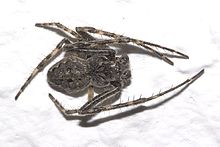Crevasse spider
| Crevasse spider | ||||||||||||
|---|---|---|---|---|---|---|---|---|---|---|---|---|

Crevasse spider ( Nuctenea umbratica ) |
||||||||||||
| Systematics | ||||||||||||
|
||||||||||||
| Scientific name | ||||||||||||
| Nuctenea umbratica | ||||||||||||
| ( Clerck , 1757) |
The columns spider ( Nuctenea umbratica ) is the family of Real orb weavers belonging (Araneidae) Spiders . The Arachnological Society named the crevasse spider of the year 2017.
features
Crevice cross spiders are about as big as the well-known garden cross spiders , males are 7 to 10 millimeters long, females are 13 to 16 millimeters long. The very hairy front body ( prosoma ) is dark brown and lightened reddish brown in the front part.
The rear body ( opisthosoma ) is, in contrast to most other Central European representatives of the family, strongly flattened dorsoventrally . Relatively very large, paired depressions can be seen on the upper side, where muscles attach inside the body, with which the spider can flatten the rear body even further. The basic color varies from red-brown to black-brown with a dark, yellowish to yellowish green bordered, leaf-shaped pattern. The legs are almost monochrome dark brown, the outer leg links are clearly ringed light brown / dark brown.
distribution and habitat
The distribution of the crevasse spider is largely limited to the western Palearctic . It covers all of Europe and western Asia to Azerbaijan , as well as North Africa. There are other, isolated occurrences in Central and Southeast Asia. The species is primarily an inhabitant of light deciduous and mixed forests.
Way of life
The bicycle network is built at medium height on old trees, but also on wooden sheds and house walls. With a diameter of 45 to 70 centimeters, it is quite large, and the radii are also relatively large. The hub is eccentric and usually clearly shifted towards the hiding place of the spider. During the day it hides under loose tree bark or in cracks in bark, on buildings and in cracks in walls. After dark she sits in the center of the network. Sexually mature animals can be seen mainly from July to October. At least the females overwinter under tree bark and similar structures.
Danger
The species is widespread and common in suitable habitats. In Germany it is classified as "safe" in the Red List .
literature
- Heiko Bellmann: Cosmos Atlas Arachnids of Europe . 3rd edition, 2006. Kosmos, Stuttgart. ISBN 978-3-440-10746-1
- Herbert W. Levi: The orb-weaver genera Araniella and Nuctenea (Araneae: Araneidae) , in: Bulletin of the Museum of Comparative Zoology , vol. 146, no. 6, Cambridge 1974, ISSN 0027-4100
- Ralph Platen, Bodo von Broen, Andreas Herrmann, Ulrich M. Ratschker & Peter Sacher: Total species list and red list of spiders, harvestmen and pseudoscorpions of the state of Brandenburg (Arachnida: Araneae, Opiliones, Pseudoscorpiones) with information on frequency and ecology. Nature conservation and landscape management in Brandenburg 8, booklet 2 (supplement); 1999.
Individual evidence
- ↑ Natural History Museum of the Civic Community of Bern: World Spider Catalog Version 15.5 - Nuctenea umbratica . Retrieved September 7, 2014.
- ↑ Distribution of the crevasse cross spider in Europe on www.spiderling.de
- ↑ http://www.britishspiders.org.uk/html/bas.php?page=world&taxon_key=nbnsys0000008945 Map for the worldwide distribution of the crevasse spider from the British Arachnological Society
Web links
- Nuctenea umbratica in the World Spider Catalog
- Nuctenea umbratica in the Wiki of the Arachnological Society
- Fauna Europaea
- more pictures and information
- Nuctenea umbratica on the website of Karl-Heinz Schäffner


